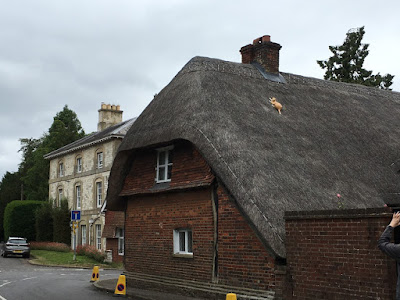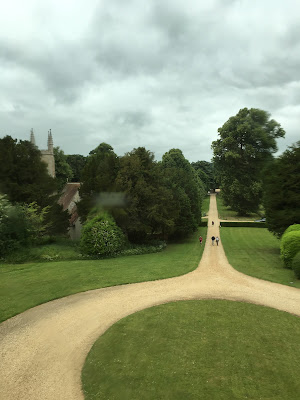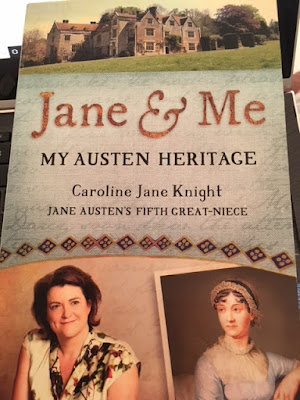What did Chawton look like when Jane Austen lived there? Who lived there and who did Jane Austen socialise with? What was life like back in the early part of the 19th Century when Jane Austen lived in the village?
Perhaps like me, you have visited the village of Chawton several times and just assumed that it looked the same as it does now, what with all the period cottages and thatched roofs. However, my perspective of Chawton changed irrevocably when I did the Chawton walking tour with historian Jane Hurst during Alton Regency Week. I now have a much better idea of how the village actually looked at the time. I will now take you on a time travel tour around Chawton and if you would like to know more, you can read Jane Hurst's guide "Jane Austen and Chawton".
The Chawton of Jane Austen's day extended to as far as the French Horn, which was already a public house at the time. It is a lovely pub that still has an oldy-wordly feel to it and I enjoyed a nice meal there with my family on an earlier trip.
Jane Austen must have walked past the French Horn while walking to the Swan Inn in Alton to pick up her post or to do her shopping.
Turning to Old Winchester Road, the Chawton of Jane Austen's day has now begun. Walking through the underpass of what is now the highway and following down the road, you enter the main road and you can soon see the Elm Cottage on your right.
William Gold, a builder, lived in this cottage and had workshops there; he is known to have built several cottages in the area, including Chawton Cottage (Jane Austen's House), and many of Edward Knight's cottages on the Chawton estate. Edward Austen Knight, one of Jane Austen's elder brothers, owned Chawton House, and several cottages here belonged to the estate. Interestingly, Edward Austen's bookkeeping survives to this day and, as it was very accurate, local historians have received ample information from there about buildings in the local area.
There are many similar red-brick cottages around the Elm Cottage, many of which are thatched. Local labourers, blacksmiths, shoemakers and butchers lived in these buildings, people that would not have belonged to Jane Austen's social circle.
Walking on, we see a vast greenland with a large building to our right. This belonged to the Prowting family, friends of the Austens: William Prowting, his wife and daughters Catherine and Ann Mary. We can tell that they were an important family in the area, as they owned a vast amount of land.
The building is modern, the earlier one having been pulled down in the middle of the 20th Century, but we do know that the old building was medieval in its layout as there is a painting of it in Chawton cottage (see below).
Jane mentions the Prowtings several times in her letters and it appears that the families visited each other frequently. Ann Mary moved to another cottage after her marriage, but the rest of the family stayed here until the death of Catherine Prowting. Edward Knight bought the house and let part of the house to his butler until he demolished most of it in 1822.
Diagonally opposite the Prowtings, there is Dower House (above), which was bought by William Prowting, and housed barns, stables, outhouses and gardens. Dorothy Webb lived in this house. The property was later acquired by Montagu Knight, squire of Chawton and Edward Knight's descendant, in late 1800s for the dowager at the time.
Close to the Dower House, there is another house also called a Dower House, also known as Denmead House. It belonged to the Prowting family as well and became the home of Ann Mary Prowting who Jane Austen mentions in her letters several times.
Jane Austen wasn't the only resident in the village to suffer a tragic death. Down the road towards Chawton Cottage, Jane Ewans lived in Ivy Cottage (below) with her husband, John, a local labourer.
At around the time of Jane Austen's death, between 1817-1818, she tragically lost six of her eight children, with only two surviving into adulthood. Her story is extremely sad and does make you wonder what was the tragic cause of death of so many of her family members so quickly one after the other.
Next to Jane Austen's cottage, there is Clinkers, a house that belonged to the Clinkers family who were local blacksmiths.
There is a forge next to the cottage (below). Blacksmiths were important, as they were needed for making farm tools, transport and door hinges amongst other things.
References:
Austen, C. (1867) My Aunt Jane Austen: A Memoir. (Published in J.E. Austen-Leigh's A Memoir of Jane Austen and other Family Recollections (2002). OUP.
Austen-Leigh, W./Austen-Leigh, R. (2009) Jane Austen, Her Life and Letters - A Family Record. Echo Library.
Hurst, J. (2009) Jane Austen and Chawton. A Walk Around Jane Austen's Chawton.
Le Faye, D. (1989) Jane Austen: A Family Record. CUP.
Perhaps like me, you have visited the village of Chawton several times and just assumed that it looked the same as it does now, what with all the period cottages and thatched roofs. However, my perspective of Chawton changed irrevocably when I did the Chawton walking tour with historian Jane Hurst during Alton Regency Week. I now have a much better idea of how the village actually looked at the time. I will now take you on a time travel tour around Chawton and if you would like to know more, you can read Jane Hurst's guide "Jane Austen and Chawton".
The Chawton of Jane Austen's day extended to as far as the French Horn, which was already a public house at the time. It is a lovely pub that still has an oldy-wordly feel to it and I enjoyed a nice meal there with my family on an earlier trip.
Jane Austen must have walked past the French Horn while walking to the Swan Inn in Alton to pick up her post or to do her shopping.
Turning to Old Winchester Road, the Chawton of Jane Austen's day has now begun. Walking through the underpass of what is now the highway and following down the road, you enter the main road and you can soon see the Elm Cottage on your right.
William Gold, a builder, lived in this cottage and had workshops there; he is known to have built several cottages in the area, including Chawton Cottage (Jane Austen's House), and many of Edward Knight's cottages on the Chawton estate. Edward Austen Knight, one of Jane Austen's elder brothers, owned Chawton House, and several cottages here belonged to the estate. Interestingly, Edward Austen's bookkeeping survives to this day and, as it was very accurate, local historians have received ample information from there about buildings in the local area.
There are many similar red-brick cottages around the Elm Cottage, many of which are thatched. Local labourers, blacksmiths, shoemakers and butchers lived in these buildings, people that would not have belonged to Jane Austen's social circle.
Walking on, we see a vast greenland with a large building to our right. This belonged to the Prowting family, friends of the Austens: William Prowting, his wife and daughters Catherine and Ann Mary. We can tell that they were an important family in the area, as they owned a vast amount of land.
The building is modern, the earlier one having been pulled down in the middle of the 20th Century, but we do know that the old building was medieval in its layout as there is a painting of it in Chawton cottage (see below).
Jane mentions the Prowtings several times in her letters and it appears that the families visited each other frequently. Ann Mary moved to another cottage after her marriage, but the rest of the family stayed here until the death of Catherine Prowting. Edward Knight bought the house and let part of the house to his butler until he demolished most of it in 1822.
Diagonally opposite the Prowtings, there is Dower House (above), which was bought by William Prowting, and housed barns, stables, outhouses and gardens. Dorothy Webb lived in this house. The property was later acquired by Montagu Knight, squire of Chawton and Edward Knight's descendant, in late 1800s for the dowager at the time.
Close to the Dower House, there is another house also called a Dower House, also known as Denmead House. It belonged to the Prowting family as well and became the home of Ann Mary Prowting who Jane Austen mentions in her letters several times.
Jane Austen wasn't the only resident in the village to suffer a tragic death. Down the road towards Chawton Cottage, Jane Ewans lived in Ivy Cottage (below) with her husband, John, a local labourer.
At around the time of Jane Austen's death, between 1817-1818, she tragically lost six of her eight children, with only two surviving into adulthood. Her story is extremely sad and does make you wonder what was the tragic cause of death of so many of her family members so quickly one after the other.
Next to Jane Austen's cottage, there is Clinkers, a house that belonged to the Clinkers family who were local blacksmiths.
There is a forge next to the cottage (below). Blacksmiths were important, as they were needed for making farm tools, transport and door hinges amongst other things.
We learnt that Chawton had their own brick and tile works and clay was readily available, which meant that everything in the village was built with bricks as they were free to the estate. Therefore most of Chawton was certainly red-brick at the time of Jane Austen.
(Opposite Jane Austen's cottage, there is the Greyfriar pub and Cassandra's Cup tearooms, which didn't exist at the time and probably had cottages in their place before being rebuilt by Victorians.)
Chawton Cottage
Turning right from Chawton Cottage, located at the junction of two important roads, we see the Baigens on our right, a very old farmhouse.
Baigens was named after the family who lived there from 1700s to the 1800s, but the house is much older, dating back to the 1500s, and used to belong to the Knight family. Apparently there are still some fascinating medieval wall hangings inside the house. In Jane Austen's time, the Baigen family lived here and the cottage was said to be in very bad condition.
Across the road, there is Thatch Cottage where Miss Benn, a spinster friend of the Austen sisters lived.
Miss Benn's brother was a minister in Farringdon but, as he had too many children to accommodate, his sister was given a part of this cottage to live in. Miss Benn was impoverished and Jane Austen described her cottage as a "wretched abode", being in bad repair, cold and damp to live in. I have previously written about how Miss Benn perhaps inspired the character of Miss Bates, who knows?
Back towards Chawton Cottage there is Chawton Lodge (above) across the road. Miss Jane Hinton lived there with her brother, John Knight Hinton and her niece, Elizabeth Wells. Jane Hinton's father, Rev Hinton, had been rector of Chawton and, when he died in 1802, she had to leave the Rectory and move here. Despite being of a similar social standing, the Austens do not appear to have been in friendly terms with the Hintons. It so turns out that the Hintons were distant relatives of the Austens and the Knights, and next in line to inherit the Chawton Estate, should the Knight line die out. Perhaps Jane was insecure about her position. Luckily for her and the other Austen ladies, Edward sorted the situation out but their friendship never appears to have been kindled.
Coming back to the crossroads where Chawton Cottage is located, Caroline Austen, Jane's niece, remembers in her memoir that "it (the house) was well placed... just where the road from Winchester comes into the London and Gosport line. The fork between the two being partly occupied by a large shallow pond, which pond I beleive has long since become dry ground". (p. 167).
On the other side of the pond towards Chawton House, there is a row of cottages called Pond Cottages (below).
In one of these cottages lived William Littleworth, a manservant of the Austens. A villager, John White, also lived here and died in 1921, aged over 100. He remembered seeing William walk down the road with Cassandra Austen's dog, Link, going to Chawton House for milk, and carrying the milk pail in his mouth on the way back!
We then see Malt House Cottages on our right (below). There was originally a malthouse with some cottages here, but Edward Knight converted the buildings into four cottages. William Goodchild, a thatcher, lived here with his wife, Mary, who was hired as a servant by Frank and Mary Austen.
If you go past Chawton House, you see what was then Chawton Rectory on your right. Mr John Papillon, rector of Chawton, had rebuilt the building in 1803 and now lived there with his spinster sister, Eleanor. Mr Papillon was a distant relative of the Austens and the Knights and they often visited them.
Jane enjoyed Eleanor's company and visited the poor with her, bearing gifts. "Yesterday Miss Papillon and I walked together to call on Dame Garnet. I had a very agreeable walk, & if she had not, more shame for her, for I was quite as entertaining as she was"..."I took (Dame Garnet) an old shift & promised her a set of our Linen, and Eleanor gave her some money and left some of her Bank Stock with her" (Austen-Leigh, ch 15). Jane Austen seems to have developed a social conscience while living in Chawton, being surrounded by people like Dame Garnet and Miss Benn, and many of the tenants on her brother's estate, who were more unfortunate than them, and she actively engaged in deeds of charity.
Mrs Knight suggested that Jane marry Mr Papillon, and it seems to have become a family joke that Jane would marry him. In 1808 Jane wrote, 'I am very much obliged to Mrs. Knight for such a proof of the interest she takes in me, and she may depend upon it that I will marry Mr. Papillon, whatever may be his reluctance or my own. I owe her much more than such a trifling sacrifice.' (p. 176, La Faye). Now we all know Jane Austen's tendency towards irony and prickly observations about the people around her!
Hope you enjoyed this little tour as much as I enjoyed Jane Hurst's tour around Chawton. To learn more about the history of Chawton, you could read her booklet and she is even happy to arrange private tours around the village.
References:
Austen, C. (1867) My Aunt Jane Austen: A Memoir. (Published in J.E. Austen-Leigh's A Memoir of Jane Austen and other Family Recollections (2002). OUP.
Austen-Leigh, W./Austen-Leigh, R. (2009) Jane Austen, Her Life and Letters - A Family Record. Echo Library.
Hurst, J. (2009) Jane Austen and Chawton. A Walk Around Jane Austen's Chawton.
Le Faye, D. (1989) Jane Austen: A Family Record. CUP.
















































